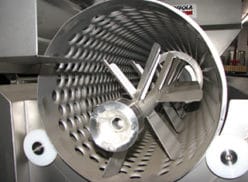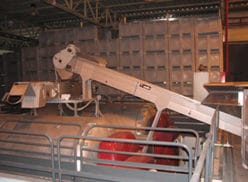
Grape crusher.
Due to the time limitation and the production processes of the harvest, it is ideal that cellar equipment functions optimally and continuously without interruptions during the harvest. In order to realise this, cellars can apply a preventative maintenance programme prior to and after the harvest to identify and prevent potential equipment breakdowns. Otherwise maintenance can be degraded into crisis management, consisting of reparations after breakdowns.
Some cellar equipment, like sorting tables, crushers, destemmers and presses, are only used during the harvest. If cellars intend to use such equipment again or adjust it, instead of buying new equipment, the adjustments and/or maintenance must be completed timeously.
The technology of grape crushers and destemmers has not changed much and its upgrading will mainly be to increase its capacity. Cage adjustments can, however, be considered to facilitate the exit of smaller or larger berries. Crushers and destemmers are usually made of stainless steel and should last for a lifetime. All crushers and destemmers have belts, pulleys and gear-driven cogs, which are usually made of plastic and need to be looked at after each harvest and replaced if necessary. The gears are made of plastic to reduce their noise levels and allow for a bit of give if in contact with the berries. If these plastic parts become brittle or change in colour, they must be replaced. The best way to do the maintenance properly, is by stripping the crusher-destemmer. It is usually installed outside and if it was designed for interior European conditions, ultraviolet damage by the sun can cause considerable damage to the rubber material. It is also advisable to cover the electrical and mechanical components with tarpaulin to prevent water running in and protect it against the sun. Storing them undercover in a shed is most preferable.
Depending on their activities or wine styles, cellars will use different types of presses, whether it is basket screw or bag presses. The maintenance will also depend on the type of press. Press technology has changed considerably over recent years and is frequently the reason for replacing existing presses. The average lifetime of a bag press is approximately 25 years. In the case of bag presses, maintenance of the bag and the electronic equipment is crucial. It is especially the components which are exposed to condensation and outdoor conditions, which need the necessary attention. Some cellars tend to keep the bag in the press, if sufficient ventilation exists. It can, however, become very warm in the bag space and rodents hiding inside the press can even eat holes in the bag. It requires much effort to remove the bag and store it elsewhere. An easier solution is to cover the drainage channels with mesh to prevent entrance into the press, but still supplying sufficient ventilation. Press bags must, however, be inspected before and after the harvest and the results recorded. If it is maintained and handled properly, it should have a lifetime of seven years. The possibility of stocking an additional new bag, can be considered, but it is very expensive and must also be stored properly. It is better to maintain a good relationship with providers, who can rather stock extra equipment and also provide good technical service (Aebischer, 2017).
Maintenance practices differ at cellars. Reactive maintenance (RM) is applied after a breakdown has already occurred and is the most expensive way of maintenance. Preventative maintenance (PM) is maintenance in preventing the breakdowns. Predictive maintenance (PdM) plans preventative maintenance according to the expected performance of equipment between breakdowns. It includes cleaning, lubrication, inspection and testing on a regular base. Advanced maintenance at cellars, however, requires a computerised maintenance management system (CMMS). A sophisticated pro-active maintenance plan can be implemented by using it. The optimal maintenance strategy will comprise of 10% reactive (RM), 20% preventative (PM), 50% predictive (PdM) and 20% pro-active maintenance. Research results showed that enterprises with an implemented computerised maintenance management system (CMMS), improved their profit by 25 – 60% and productivity by 25 – 50% and decreased equipment downtime by up to 98% and maintenance cost by 30% plus.

Presses.
References
Aebischer, C., 2017. Post-vintage winery maintenance. Australian and New Zealand Grapegrower and Winemaker, June 2017, Volume 641: 73 – 75.
Jeffrey, I., 2017. Winery maintenance and sustainability at iconic wineries. Australian and New Zealand Grapegrower and Winemaker, June 2017, Volume 641: 64 – 65.













